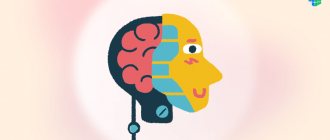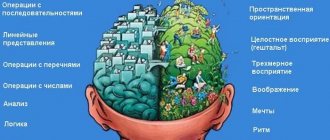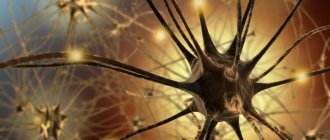“The left hemisphere of the brain is responsible for logical thinking, and the right hemisphere is responsible for creative thinking” - this “saying”, like many others like it, is very common not only among ordinary people, but also among specialists - even in books devoted to correct thinking , self-development and some other similar topics you can find a lot of them. But what is most interesting, surprising and strange is that these myths, one can put it bluntly, relate very, very little to the true state of affairs.
The myth that the cerebral hemispheres are functionally asymmetrical is one of the most popular myths regarding the brain that can be found today. Along with the myth that a person uses only 10% of his brain, he is, perhaps, a leader.
Despite this, even seemingly professional specialists with serious scientific knowledge and all kinds of degrees and titles often claim that this myth is the purest truth, and “stuff” it into the minds of ignorant people. The good news is that the myth about functional asymmetry of the cerebral hemispheres has been dispelled for quite some time. But let's not get ahead of ourselves.
Reasons for the emergence of the myth about functional asymmetry of the cerebral hemispheres
The myth about the functional asymmetry of the cerebral hemispheres appeared for a reason. By and large, the reason for its emergence was the results of studies conducted with people with “split brains”, which were organized by the American neuropsychologist and professor of psychobiology Roger Sperry and a team of his colleagues.
During the research, scientists performed surgeries on people with “split brains,” during which they cut the corpus callosum, which connects the right and left hemispheres of the brain to each other. Through such an operation, which, by the way, was the most extreme option for help, it was possible to relieve patients with severe epilepsy from severe epileptic seizures.
Thanks to laboratory studies of patients with the above-mentioned disease, it was possible to identify their behavioral changes, which indicated that the hemispheres of the brain worked independently of each other. For example, patients, when they felt an object with their right hand, could recognize it and point to its image, but were not able to pronounce the name of this object. And if you install a partition between the eyes of a person with a “split brain”, and then show the left eye (right hemisphere) a photograph of a naked person, he will immediately begin to chuckle. If you ask him what caused his fun, he will answer something like “in the photo I saw my cousin, who always makes great jokes.” The left hemisphere of the brain does not recognize the photo, but given that for the most part it is responsible for processing verbal data, it will independently form some plausible explanation.
Thus, by presenting different stimuli to different hemispheres, separately from each other, scientists were able to find out that they are capable of performing various mental actions with relative success. For example, in a larger number of people, those areas that are responsible for the primary processing of speech data (word formation, grammar, etc.) are located in the left hemisphere, and the right hemisphere takes part mainly in the processes of emotional assessment of phenomena, events and objects .
In addition, the right hemisphere of the brain was very active when a problem given to a person was solved with the help of insight, where awareness of the problem and the search for a solution are carried out spontaneously, one might say, at the level of intuition, which is similar to creative thinking.
But, despite this, the differences between the left and right hemispheres cannot be considered clear and clear to such an extent as to draw any specific conclusions. And in most cases, the conversation is not about the fact that one hemisphere is not capable of performing some function, but about the fact that one hemisphere can perform this function more efficiently and quickly. For example, despite the fact that the main role in speech processing belongs to the left hemisphere, the right hemisphere also takes part in this process, processing intonation, etc.
How does the right hemisphere drawing technique work?
Do you remember why the hero leading the narrative in The Little Prince abandoned his “brilliant career as an artist”? That's right - the adults mistook his boa constrictor, which swallowed an elephant, for a hat.
Children think unconventionally because their knowledge and experience are limited. The left hemisphere of the brain is not yet dominant—there is no habit of “thinking rationally.”
Now imagine that you need to draw a house. As soon as you think about it, the left hemisphere immediately turns the house into a square (building), a triangle (roof) and a cylinder (pipe). As a result, instead of a solid image on the sheet, you will get a set of geometric shapes that make up the home. But if you turn on the right hemisphere, the drawing will come out more detailed and alive.
The absence of analysis allows you to relax and enjoy the process of right-hemisphere drawing. The main thing is to overcome the fear of “drawing something different”
The real state of affairs
Everyone should understand that in a healthy person, the right and left hemispheres are interconnected with each other, and information is constantly exchanged between them, which means that what is available to one hemisphere is also available to the other. In addition, analysis of the data presented by functional MRI showed that both hemispheres “communicate” with each other in the process of solving most problems.
Based on all this, the nuances that indicate the difference between the two hemispheres of the brain are incomparably smaller than those who adhere to the opinion about the functional asymmetry of the hemispheres claim. The functions performed by both hemispheres are more similar to each other than different.
Neuroscientists of the new generation express their disagreement with representatives of their science, who are of the opinion that the two hemispheres are “different” and claim that they see the surrounding reality differently - that the left hemisphere is responsible for logical thinking, and the right is responsible for everything related to creativity .
Among other things, complex forms of activity (creativity, etc.) can include not only creative tasks, but also quite ordinary and routine ones, so even if we look at the issue of differences between the hemispheres from the perspective of people who share the functions of the right and left hemispheres , success in the same creativity is, of course, due to the successful functioning of both hemispheres.
The nature of the left hemisphere
Left-hemisphere people are often emphatically rational and reasonable. They write a lot and willingly, they easily remember long texts, and their speech is correct. They are characterized by a heightened sense of duty, responsibility, integrity, and the internal nature of processing emotions. They often occupy administrative positions, but they lack flexibility, spontaneity and spontaneity in expressing feelings. They prefer to act according to pre-drawn up schemes and stencils, and have difficulty rebuilding their relationships.
Reasons for the popularity of the myth of the left and right hemispheres of the brain
So for what reason is the myth about the functional asymmetry of the cerebral hemispheres so firmly ingrained in people’s consciousness and has become extremely widespread?
One of the reasons is the very simplicity of the interpretation of the work of the brain, which, in addition to everything else, quite easily fits into the framework of common sense. On the one hand, a person has to perform various types of activities that are radically different from each other, but on the other hand, the brain has two similar halves. But why do the brain need them? Most likely, precisely so that they perform various tasks.
Another reason is that the myth we are considering is actively cultivated by popular scientists who are trying to make money from it. Pointing out that modern society is not able to fully appreciate the emotional perception of reality, which is a property of the right hemisphere, adherents of the difference between the hemispheres began to advertise intricate schemes for increasing the activity of the hemisphere, as if responsible for creativity. Numerous seminars, trainings, publications and books by these people promise to those who want to develop to remove from their path of personal development any barriers that are imposed on a person by the ossified system of basic education, which specifically approves of “left-handed” thinking.
Those who strive to develop the right hemisphere have at their disposal a huge number of exercises, which in themselves are completely harmless and even extremely positive, but have nothing to do with this very “development” of the right hemisphere. But the situation is aggravated by the fact that many “specialists” often suggest that people start using some special devices that harmonize and synchronize the work of both hemispheres.
Of course, there is no evidence that a person is able to learn to use a specific hemisphere of the brain separately from the second, or, conversely, learn to use them harmoniously. In fact, if the human psyche works normally, then this work requires the activation of various parts of the hemispheres, and not their synchronization at the first request of the “owner”.
So, remember that during the work of a healthy person’s brain, his hemispheres are in the process of interacting with each other, and the work of these hemispheres itself is harmonized exactly as needed. So you shouldn’t do “it’s not clear what” - it’s better to throw out of your head the idea that the hemispheres of the brain are responsible for different functions, and just start developing your thinking, regardless of what activity you’re doing - logical or creative.
We also recommend reading:
- Storytelling
- Mental arithmetic
- How does the human brain work and what are its functions?
- Is there a connection between humor and intelligence?
- Meditation practice in the modern world
- “Are you out of your mind?” or 32 exercises for brain development
- Brain development: useful tips and exercises
- How to get more done in 24 hours
- Brain structure
- “Have you seen it” or Where does the deja vu effect come from?
- Neurolinguistics: Brief Description and Key Ideas
Key words:1Cognitive science
Preparing your brain for training
Any athlete will confirm that the body must be prepared for intense training. It's the same with the brain. To begin intellectual development, you should help the brain become more plastic and ready to learn new material.
These tips apply to both adults and children:
- Increase your physical activity. If you sit all the time, blood circulation in the body is disrupted and fatty acids begin to break down worse. As a result, the brain receives insufficient oxygen and it becomes more difficult to think.
- Train yourself to drink enough fluids. Water cleanses the body of toxins and maintains brain vitality.
- Eat foods rich in healthy carbohydrates (kefir, fish, rice, corn flakes) and phosphates (nuts, beans, pumpkin, processed cheese).
Read about the peculiarities of thinking in our separate publication.
How children learn to draw
Betty Edwards carefully studied and observed how children learned to draw. Here's what she found.
Around one year old, children begin to master the first “doodles” with pleasure, chaotically moving a pencil or brush across the paper. And this gives them great pleasure.
Drawing of a 1.5 year old child
By the age of two, the child begins to realize that his drawing can represent something that exists in the real world. So, for example, a circle is drawn, two dots-eyes are added, a stick-mouth is added and you get a mother. In this way, the child begins to develop his own symbol system. Using the same symbols, the child himself, dad (only bigger), mom (long hair is added), grandmother (glasses are added), etc. are drawn. The little artist draws similar pictures day after day, honing his own symbols.
Drawing of a 4 year old child
Around 4-5 years old, the child begins to master landscapes in which the same house with a window and door is also repeated day after day; traditional earth - green stripe at the bottom of the picture, sky - blue stripe at the top, sun, tree. Then the girls begin to draw princesses and fairies, and the boys begin to draw transport and superheroes. At the age of 10-12 years, a child develops a craving for realism, a great desire to draw an object as it really is. Those who fail to do this simply lose interest in drawing and in adulthood their ability to draw remains at the level of a 12-year-old child. The other part of the children still develop the ability to “see” an object like an artist and achieve success in drawing.
Thus, when an adult is asked to draw something on paper, he turns to the symbol system developed in childhood and stored in the left hemisphere. A person only glances briefly at the object and begins to “give out” familiar symbols on paper: here is a symbol for the eye, here for the nose, and here are the lips. How to resolve this dilemma? Psychologist Robert Ornstein argues that in order to paint, the artist must reflect objects like a mirror, perceiving them exactly as they are. Thus, we must turn off the dominant mode of the left hemisphere and trust the other, artistic and creative side of the brain.
Everyone can draw. You just need to stop thinking and analyzing your actions during the process, and just immerse yourself in the creative process))))
The main idea of right-hemisphere drawing
How can one still shift the artistic task from the left to the right hemisphere and won’t it also object)))? American teacher Betty Edwards devoted herself to this issue. Betty taught and did research at California State University. The result of her work was the book “Discover the Artist in You.”
In her book, Betty Edward compares learning to draw to learning to ride a bicycle. It seems that everything is simple: you sit on a bicycle, pedal, keep your balance and go! But in practice this does not work the first time; you need to try once and twice until you can coordinate all the movements. It’s the same with drawing: you need to take a pencil and just draw what you see, you just have to learn to “see” correctly.
With the help of some exercises, you can develop this ability to “see” like an artist, and, consequently, to draw! So Betty Edwards suggests:
— Try to draw an ambiguous picture, like a vase-face. This also helps to learn how to work with images, to draw what you see (a line, a curve), and not “break it down” into components (forehead, nose, lips).
- Draw a negative - that is, what we would see if we took a photograph of the picture and looked at the negative. Or in another way it is called “drawing empty space”: that is, we draw not the object itself, but the space that surrounds it. It also teaches you how to work with images.
In general, the book contains a number of sequential exercises that step by step reveal the capabilities of the right hemisphere.
Many teachers, psychologists and artists became interested in Betty’s technique, each developing it in their own way and offering their own methods. Modern psychologists also offer their exercises and techniques at seminars and trainings.
- Draw beyond the paper. This is a special exercise: by going beyond the boundaries of paper, a person goes out of his framework, which limited him and interfered with creative development.
How to draw with your child
Of course, in order to competently guide young talent and give tactful advice, working with a child requires a sensitive psychologist, an experienced teacher and a talented artist all rolled into one. At first, mom will do an excellent job with this role.) Here are a few exercises that stimulate the work of the right hemisphere.
* Drawing imaginary objects. Before you draw something, invite your child to dream up. It is advisable to imagine something that he has not seen in reality: a fabulous animal or a fantastic flower; your future profession or even your name. Discuss with him the color, smell, taste of the object, what it feels like, what sounds it makes. Only after the child’s imagination “runs wild” should you invite him to draw an imaginary thing.
* Mirror drawing. Take a blank sheet of paper and two pencils - one in each hand. Invite your child to draw mirror-symmetrical drawings (or letters, if the child is already familiar with them) with both hands at the same time. When performing this exercise, both hemispheres are involved, which improves the efficiency of the entire brain.
Example of mirror-symmetrical patterns
* Drawing on colored paper. Offer your child several multi-colored sheets; the child himself must choose on what background he wants to draw. The very process of choosing a colored sheet already excites the imagination, activates work with images and associations, i.e. “turns on” the right hemisphere.
White animal on a black background. Black color for children is not gloomy, but interesting, as children choose it based on contrast
* Drawing with the other hand. If the child is right-handed, then it is worth offering him, as an experiment, to draw with his left hand (for left-handed people, on the contrary, with his right hand). Firstly, it uses new parts of the brain, and secondly, it’s just fun!
Harmonious interaction of the hemispheres
Both the right and left hemispheres are equally important in a person. And even the greatest artists need to write, count, and think in life. It’s good when the right hemisphere is developed, great when the left hemisphere is developed, and great when both are developed. And it is important to remember that drawing lessons for both children and adults are not carried out in order to become an outstanding artist (although this is also not excluded), but in order to be a harmonious person, in order to reveal the full potential inherent in nature.
Source
Everyone can draw or What is right-hemisphere drawing?
According to the idea of right-hemisphere drawing, everyone can draw! How is this possible? Let's figure it out
Looking at the paintings of great artists, we all admire: “Oh, what talent!” and somewhere in the depths of our souls we regret that we do not have such a gift, but we would like to... at least a little! According to the idea of right-hemisphere drawing, everyone can draw! How is this possible? Let's figure it out.









